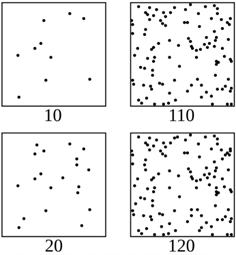The Link Between the Physical World and the Mental World – The Birth of Psychophysics

When the number of dots increases from 10 to 20, the difference is easy to spot. However, when the number increases from 110 to 120, the difference becomes much harder to detect. Because our mental world does not operate on the same scale as the physical world. And people begain exploring the relationship between the two centruies ago.
In the early 19th century, the German physiologist Ernst Heinrich Weber became interested in how small a change in a physical stimulus a person could detect, which gave rise to the concept of the Just Noticeable Difference (JND) (Murray & Ross, 2018).
In his pioneering series of experiments, Weber asked participants to perform weight discrimination tasks. Participants held a baseline weight (e.g., 1 kg) in one hand, then Weber either added or replaced it with a slightly heavier or lighter weight. They were then asked to report whether they perceived a difference. Weber repeated this procedure with different baseline weights to see how the detectable difference varied. He found that the JND increased with the base weight, but the ratio of the JND to the base weight remained roughly constant. He thus proposed that perceptual sensitivity depends on the proportional rather than the absolute difference.
Weber’s findings were revolutionary because they revealed that human perception is relative, not absolute. And this explains why we can easily notice the difference between 10 and 20 dots, yet struggle to distinguish 110 from 120.
Weber’s student, Gustav Theodor Fechner, extended these insights further. Building on Weber’s work, Fechner transformed the study from qualitative descriptions to quantitative, mathematical relationships between physical stimulus and subjective sensation. His key theoretical contribution was the assumption that subjective sensation grows approximately as the logarithm of the stimulus intensity. In other words, when the physical stimulus increases geometrically, the perceived sensation increases arithmetically (Algom, 2021).
In 1860, Fechner published “Elements of Psychophysics”, which formalized the field of psychophysics, the quantitative study of the relation between physical stimuli and psychological sensations (Fechner, 1948). This work established psychophysics as a scientific discipline grounded in measurable variables and formal laws.
Although the Weber-Fechner Law has several limitations, for example, it only holds within a moderate range of stimulus intensities and is inapplicable to certain sensory modalities like pain and taste, it marked the birth of psychophysics. Their work introduced the idea that subjective sensation can be described mathematically and proposed the first formal equation linking physical intensity to subjective sensation. Their foundational ideas paved the way for later developments, such as Stevens’ Power Law.
References:
Algom, D. (2021). The Weber-Fechner law: A misnomer that persists but that should go away. Psychological Review, 128(4), 757–765. https://doi.org/10.1037/rev0000278
Fechner, G. T. (1948). Elements of psychophysics, 1860. In Readings in the history of psychology (pp. 206–213). Appleton-Century-Crofts. https://doi.org/10.1037/11304-026
Murray, D. J., & Ross, H. E. (Eds.). (2018). E.H. Weber On The Tactile Senses. Psychology Press. https://doi.org/10.4324/9781315782089